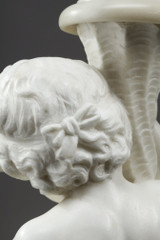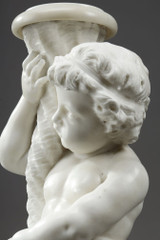A pair of Carrara white marble sculptures, made in Italy at the end of the 19th century. These mythological statuettes depict two putti holding a cornucopia in the shape of a triton shell. Each putto, draped in fabric, stands in contrapposto. One of them wears a ribbon ending in a bow.
Putti ("putto" in the masculine) are figures of naked male children, with generous forms, without wings (unlike the Amorino) and laughing, inspired by Greek art and Ancient Rome.
In Greek mythology, the cornucopia is a symbol of wealth and fertility. One version tells of the horn of the goat Amalthea, who nursed Zeus when he was still a child, producing nectar and ambrosia that granted immortality.
In Ovid's epic poems, the legend evolves: Amalthea the goat is transformed into a nymph. Rhea, mother of Zeus, entrusted her child to her care to protect him from his father Cronus, who had been foretold that one of his children would overthrow him. She cared for the young god, nourishing him with the milk of a goat; but when the goat broke one of its horns, "Amalthea picked it up and surrounded it with fresh herbs, filled it with fruit, and presented it to Zeus's lips." This is an emblem often found on benevolent divine figures such as Bacchus, Ceres, Cybele, or Fortune.
It is possible to buy the pair of decorative pedestals adorned with crystal trumpet vases .
Circa: 1890
Putti dimensions with ribbon: L: 24 cm x D: 21 cm x H: 68 cm
Putti dimensions without ribbon: L: 26 cm x D: 21 cm x H: 66 cm
Base dimensions: 21 cm x 21 cm (8.3 in x 8.3 in)
Tray dimensions: 10.5 cm x 10.5 cm (4.3 in x 4.3 in)
Total dimensions: Dim: L: 24cm, D: 21cm, H: 68cm. (W: 9.4in, D: 8.3in, H: 26.8in).
Condition report : In good condition.
- Reference :
- 3270
- Width :
- 24 (cm)
- Height :
- 68 (cm)
- Depth :
- 21 (cm)
- Era ::
- 19th century
- Style ::
- Neoclassical
- Materials :)
- Carrara marble, crystal, bronze
- Identifier Exists:
- False
















































